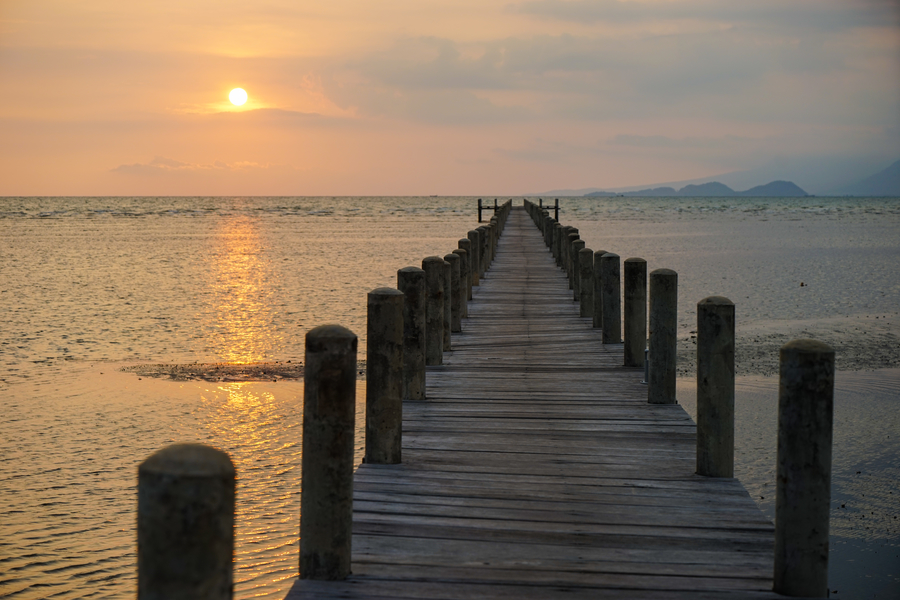A bittersweet memoir of Cambodia’s southern coast
Sometimes the idea of something is more real than the reality. Just knowing that beauty and purity exist somewhere in the world is enough to soothe the soul. Like the stained glass majesty of Paris’ Notre Dame Cathedral. The regalness of the world’s most famous princess even when no longer married to a prince. But when that beauty is suddenly stripped away, in a tragic fire or a horrific accident, a part of you mourns, not necessarily for the loss itself, but because the idea of it can no longer bring you joy.
For me, living in hot, sweaty Phnom Penh nearly two decades ago, that perfect idea was Sihanoukville, a sleepy beach getaway on Cambodia’s southern coast. Just the thought that at any given moment, I was only a four hour bus ride away from its wide, pretty beaches sipping dollar coconut shakes and nibbling on freshly grilled squid somehow made the unbearableness of Phnom Penh’s muddy roads and oppressive heat just a little bit more bearable.
Originally called Kampong Som, Cambodia’s only deepwater port was renamed Sihanoukville in the early 1960s after beloved King Norodom Sihanouk, considered the father of modern Cambodia. But to many of us Phnom Penh’ites, it was simply and affectionately known as “Snooky”. After many years away, I recently returned to Sihanoukville hoping to relive the sundrenched memories of my youth. But instead of stained glass windows and a pretty people’s princess, I found a heap of smoldering ashes, wrapped up in a mangled shell of a car.
Standing at the iconic Golden Lions roundabout, the very heart of Sihanoukville, I find my circa 2001 inner compass hopelessly spinning in circles. The night market should’ve been to my left, Pub Street straight ahead with Serendipity Beach just beyond, and the windy road to my favorite seafood restaurant to the right. Instead, there are three dozen construction cranes in every direction, busily putting up massive casinos and hotels as far as the eye can see. My “Snooky” was gone, and in its place was a noisy, dusty imposter, a war zone of a construction site I didn’t recognize. It even goes by new names now: “Westport” as it’s known to the Chinese, and “Macau ti pi” or “Second Macau” by the Khmers.
“Counting just the legal ones, there are about 150 casinos already operating and probably about 500 when all the construction is done,” says Stuart Johnstone, a member of the Sihanoukville Chapter of the Cambodia Hotel Association. Just to put those numbers into perspective, Macau has 41 casinos and Las Vegas has 104.
On our dark tour of Chinese-invested casinos, restaurants, and hotels that have taken over Sihanoukville, every other sentence from Stuart starts with “This used to be…” followed by a name I hadn’t thought of in over a decade, and with it, a flood of pleasantly patinated memories suffocated in a cloud of lime and dust. We drive by one casino sign written in stilted Chinglish. “Make Memories Alive”, it proclaims. It would’ve been humorous had it not cut to the quick.
In recent years, China has become Cambodia’s number one ally, investing more money into the country than Cambodia’s own government. In 2008, a tax-free special economic zone was established in Sihanoukville as part of China’s Belt and Road infrastructure development initiative with plans to upgrade the 11sq km area to eventually accommodate 300 companies and up to 100,000 workers. Back then, the Chinese influence was hardly noticeable, mostly confined to out-of-the-way factories featuring Chinese names and cheap Cambodian labor. Today, though, what began as an imperceptible trickle has turned into a tsunami of Chinese investments (more than USD1.1 billion in 2017 alone), completely washing over this once sleepy town with a speed few could have predicted.
Boom or Doom?
“When I moved to Sihanoukville in 2017, there were absolutely no signs of the changes to come,” says Paul, a British expat who custom-built what he hoped would be his dream retirement home. In just two years, the city has morphed from backwater resort town to booming casino mecca—by the Chinese, for the Chinese. “I know someone who had a villa near the center of town,” Paul relates. “One day, a Chinese man knocked on the door offering to pay USD10,000 monthly rent, and would even add a swimming pool for free. How do you say ‘no’ to that kind of money?”
For landowners, skyrocketing rents and property values have been a boon, but for ordinary people, not so much. “My oldest friend in the world ran a restaurant for 20 years,” says Stuart. “One day, the owners came to raise the rent from USD2,000 a month to USD16,000. It was bulldozed within a day. For the average worker, things have not worked out. Rents have gone up. Food has gone up. City beaches have evaporated. It’s all new high-rise buildings now.”
But it’s more than just the physical landscape of the city that’s changed. The whole essence of Sihanoukville’s laidback charm has vanished, where expats and Khmers once cohabited in an easy alliance fueled by foreign backpackers and families from Phnom Penh looking for a chill getaway. “Japanese restaurants, steakhouses, Khmer restaurants, expat restaurants, they’re all gone now,” sighs Stuart. “And when the expats left, they took their stuff with them, their boats and dune buggies. It’s hard to find things for people to do.
The payoff for all the upheaval was supposed to be prosperity all around in the form of more and better-paying jobs and improved infrastructure. In fact, work has started on a USD2 billion, Chinese-built four-lane expressway between Phnom Penh and Sihanoukville and the airport is being expanded to accommodate even more international tourists. Chinese travelers top the list of visitors to Sihanoukville, with a 10 percent rise in the first half of 2018. The year before that, 120,000 Chinese tourists came, which itself was four times as many as the previous year. “The trouble with Chinese guests is they don’t like Khmer food so they don’t support Khmer restaurants. They like their Chinese hotels where they can smoke in their rooms. It’s all just casinos and bedrooms now, but without the entertainment aspect like Vegas or Macau.”
In the meantime, however, residents are having to put up with congestion caused by an endless procession of construction trucks along with daily power and water outages, a result of resources being funneled to the building sites and casinos.
“Look on the bright side. At least having all these Chinese restaurants must be some consolation,” I jokingly say to Paul, seeing the rows of restaurants serving up dishes from Sichuan to Shanxi and everywhere in between. “It would be if they weren’t downright hostile to non- Chinese guests,” he retorts.

Unable to give up on my quest for the Snooky I once knew, I make my way to Naia Resort on Otres 2, the farthest beach from town. Despite telltale construction along the way, it’s one of the last holdouts of Old Sihanoukville where sun-seekers can still happily throw back tropical drinks and feast on Western comfort food while getting massages on the beach by smiling Khmer ladies.
“This stretch of beach is thankfully still quite untouched,” says Stuart who manages the 32-room boutique property with a retro 1950s Palm Springs vibe. “Otres 2 has always been known for being a secluded, quiet getaway, with good food and a family-oriented atmosphere.”
While the high-rises of Sihanoukville are just visible in the distance, this stretch of tranquil beach at least feels like a world away, a distinction Stuart is eager to make. “The poor reviews that people leave about the city of Sihanoukville are killing our scores,” he laments. “Why should people be describing a city that’s 7 km from here?” Over a plate of tender BBQ ribs and a couple of cold beers, I share with Stuart that this scene right here, right now, reminds me of the Sihanoukville I used to love, before paradise got paved over. “It’s beautiful and relaxing,” he agrees. “You’re here in Otres, not Sihanoukville. This place retains what was great about the outer beaches. Not all is lost.”
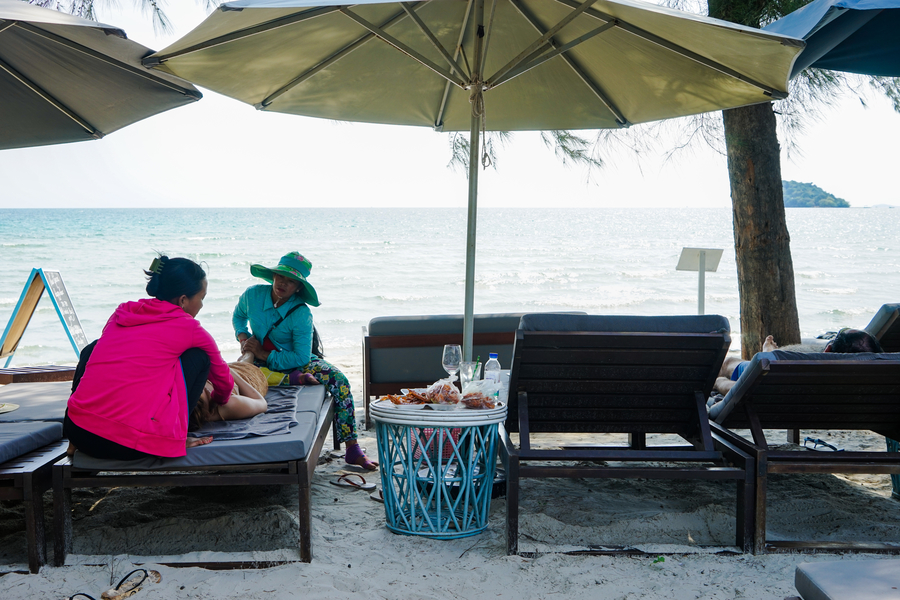
Ream Dreams
Wondering how far the building frenzy has spread, I travel another 10 kms east, to Ream National Park, 21,000 hectares of land and marine habitats that are home to several rare and endangered animal species. Way back when, Ream was where travelers in the know went to feel comatose compared to simply sleepy in Sihanoukville. I remember sleeping on a simple wooden platform with just a pillow and a mosquito net, the sound of waves washing up on shore, carrying not just a saltiness in the air but an actual, natural fishiness.
“Ream National Park in Cambodia is one of the most beautiful places you will ever find,” proclaims its official website, “because up until recently this was a land that was virtually untouched. The national park had existed for years, but no man made intervention was spoiling the location… The Ream National Park in Cambodia is a place that words cannot do justice to.”
Driving through the park, those last few words from a woefully out-of-date website ring eerily true. There are no words and certainly no justice to be found in the giant tracts of upturned red earth, the billowing smoke from landclearing fires, the charred remains of tree trunks behind “Coming soon!” signs picturing glitzy casino resorts. “This is fake, not a real park,” says Putsa, my guide for the morning, his voice heavy with disbelief upon seeing what were forests just weeks ago. I question how even the sanctity of a national park could fall casualty to development. “When the money flow into the pocket, they close their eye,” he answers quietly. It turns out that at least 3,300 hectares of the park, including 28 kms of coastline, have already been slated for development.
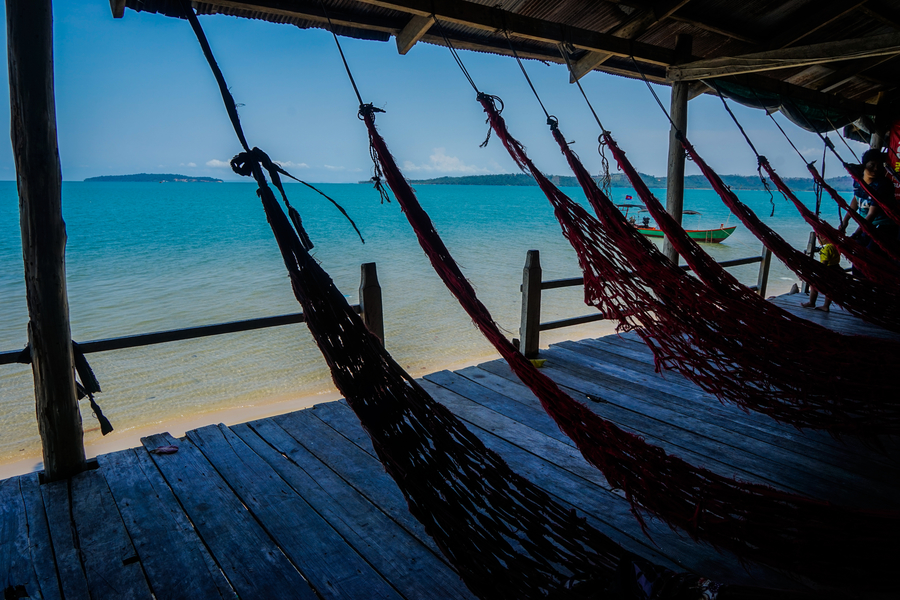
Later in the morning, we do manage to find pockets of blessed solitude. A deserted beach with frayed swings swaying in the breeze. A row of hammock cafes overlooking brilliant blue water. A hilltop pagoda with Angkor Wat-like stone carvings surrounded by the deafening sound of birds and cicadas, a welcome alternative to the cacophony of heavy machinery. In search of some kind of redemption, I board a speedboat for Alila Villas on the island of Koh Russey, literally putting the disturbing scenes of the past few days in my wake. Although barely six months old, the 63-villa resort is already EarthCheck certified for its sustainable planning and design. Over the next few days, I walk the spacious grounds including the perfect 1.5kmlong crescent beach, past a water bottling plant, a waste incinerator, and the beginnings of an organic garden. “What we’re seeing with the islands is the Cambodian government being a bit more picky,” says Marketing & Communications Manager Christophe Parault over a plate of delicious fish tacos. “There’s an eye towards preserving more of the identity of the islands by keeping development on a small scale, focusing on ecological resorts versus big casinos”.

“These islands are like their own little ecosystem, relatively untouched, that benefit from easy accessibility but that are remote at the same time,” notes Christophe. “To that end, we’re aiming for a very low footprint where we’ve only developed 15 percent of the island, leaving the rest in its natural state.” Instead of changing the natural topography, the resort works with it, building seating areas into its slopes and collecting rainwater for irrigation. As a brand, Alila is working towards a Zero Waste to Landfill policy, acting as an innkeeper of conservation, not just of natural resources, but of cultural ones as well. I find subtle elements of Khmer culture throughout the resort—the crosshatch motif of the ubiquitous Khmer krama (scarf ) in the design of the Welcome Pavilion and the headboard of my bed while the beachfront infinity pool cleverly incorporates the geometric layout of Angkor Wat into its cascading water feature.

“The development of these beaches and these lands is inevitable,” says Christophe. “The little bungalow on the beach will only be there for so long until it appears on someone’s Instagram and a hundred people show up. But because these islands are limited by space, it’s a natural antithesis to places like Sihanoukville which are filled to the brim with tourists.”
The next day I island hop over to neighboring Koh Krabey, the site of the brand new Six Senses Resort. Similar to Alila, the landscape is made part of the resort where its 40 free-standing pool villas are built right into the hillsides making them almost invisible from afar. Whereas Alila’s long stretch of beach invites guests to be social, Six Senses’ beautifully finished villas encourage privacy. I only tear myself away for meals and the odd outing—a walk along the boardwalk to the ice cream parlor for complimentary sorbet, a wellness screening and massage at the stunning
2,000 sqm spa, or a lie in on the pretty cove beach. I borrow snorkeling gear and aqua boots and wade out into the calm, clear waters to find construction of a different kind—parrotfish nibbling away at the colorful hard coral and turning it into sand, the distinctive crunching sound ringing in my ears.
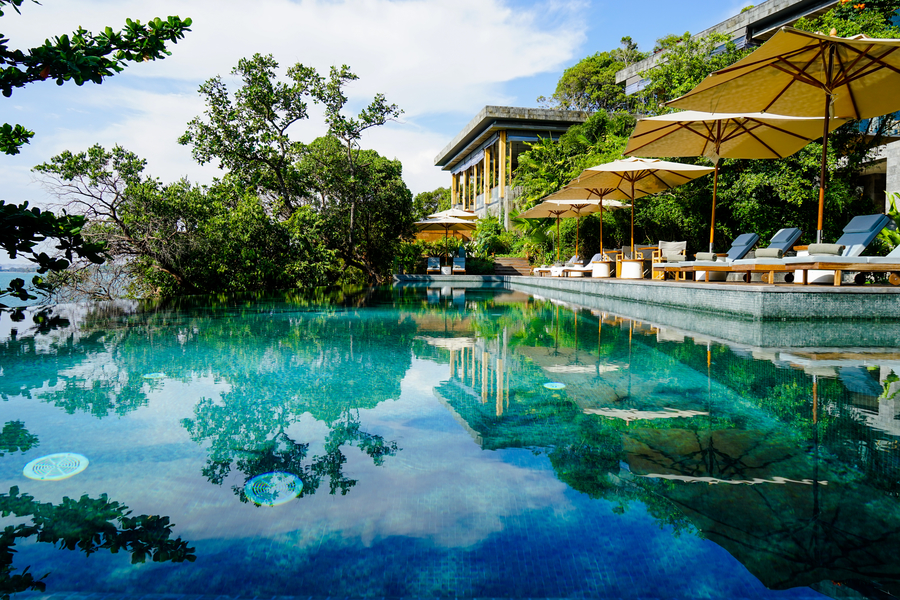
Six Senses Koh Krabey is also doing its part as a luxury eco resort. Careful thought has gone into materials, from using wooden toys in the Kids’ Club and recycled plastic for design elements to metal straws and refusing any plastic from their vendors. Located on an island, being as self-sufficient as possible isn’t just Earth-friendly, it’s also practical. There’s an on-island desalination plant where drinking water is infused with minerals before being put into reusable glass bottles while the kitchen makes everything from jams and sorbets to its own almond milk and pumpkin seed chai. “Being sustainable costs more,” explains Resort Manager Mart Trinidad, “but it’s our passion. We’re aiming to be a plastic-free company within the next two years.”
Hoping to avoid the fate of Sihanoukville and Ream for future generations, the resort also organizes environmental education. “Just last month, we went into the local school and talked about World Water Day and taking care of the environment. The kids drew their interpretation of conservation and we showcased the drawings in our spa,” says Mart. “But more than anything, I’m proud that we’re seeing a change in our staff. Sustainability wasn’t in their DNA but we’ve infused it into them to the point where they’ve spread the message to family and friends to help with rubbish cleanup and to stop using single-use plastics.”
The Spice of Life
Reluctantly returning to reality from the intoxicating escape provided by the twin island paradises, I next follow the expat exodus east, towards Kep and Kampot. Shielded by a government-struck monopoly with megacasino NagaCorp prohibiting any other casinos within 200 kms of Phnom Penh, these two towns have become the new homes of choice for those priced out of the market in Sihanoukville.
I arrive in dusty Kampot, with its quiet tree-lined streets and picturesque riverfront. Once Cambodia’s main port before the creation of Sihanoukville, Kampot feels like a town frozen in time. The Old Quarter just alongside the Praek Tuek Chhu River is a lovely mix of faded French colonial buildings next to colorful Chinese shophouses. “There are four reasons to come to Kampot,” says Chenda from Butterfly Tours as we sit by a ginormous lotus pond, sipping on sugar cane juice. “The countryside has pepper plantations and salt fields, the river that runs through town is really peaceful, we’re close to the beaches of Kep, and Kampot is one of three Cambodian towns that’s kept its heritage identity.”

We spend the afternoon admiring some of Kampot’s more than 500 colonial-era buildings—an Art Deco theater in lovely shades of pastel, a historic fish market turned trendy restaurant, and several buildings impressively restored to their original glory, including the former Governor’s Mansion, now the Kampot Provincial Museum.
As we walk, I also notice the street art found at each roundabout, many featuring Kampot’s famed products of durian, fish sauce, and pepper, the latter so unique as to have EU-protected status. To find out more, we head out for a tour of the Kampot countryside. We pass picturesque salt fields where workers flood the shallow pools with sea water, wait 2-3 days for the water to evaporate, and rake up the resultant crystals. We also visit a pepper plantation producing green, black, white, and red pepper. It’s said that Kampot pepper gets it intense flavor from a unique combination of quartz found in the soil as well as the warm, humid air rolling in from the sea and trapped by the surrounding mountains.
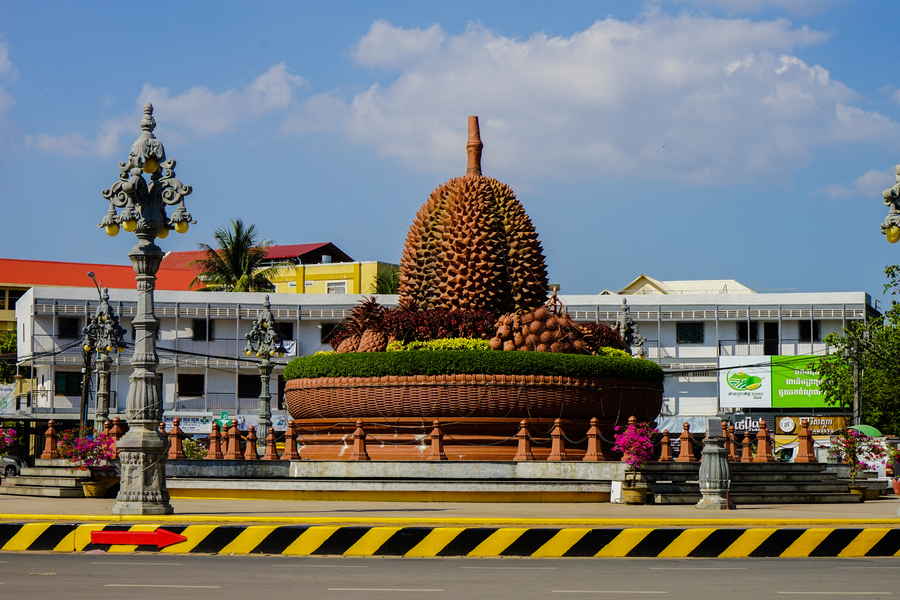
It’s little wonder that these serene surroundings have attracted a community of expats searching for a quiet, laid-back lifestyle. “Kampot is for families, people who aren’t into girlie bars,” says James, originally from Iran, but moved to Kampot nearly four years ago to open up a Middle Eastern restaurant. “The town attracts people with an alternative lifestyle – hippies, artists, people who do yoga,” he says, sporting a t-shirt that reads “Why have abs when you can have kebabs?” Right on cue, a customer pulls up with an empty container to be filled with baba ganoush. “I’ll come by and pick it up tomorrow?” he asks.
A happy by-product of this recent wave of expats is a surprisingly robust food scene. After using Iranian lavash bread to wipe up a wonderfully pungent garlic dip that accompanies my USD6 chicken shawarma, I walk the Old Quarter chock full of ethnic restaurants that span the globe, including French and Italian, but also Israeli and Portuguese. “The food here is really authentic,” says Kananda, originally from Phnom Penh. “In Phnom Penh, most of the Western-style restaurants are actually owned by Khmers, but here, it’s the expats themselves who own and operate them.” Three years ago, lured by Kampot’s timeless charm, Kananda and his wife decided to open up a luxe boutique hotel here. “Kampot is a great place to live,” he says. “It’s quiet. It’s easy to get from Point A to Point B and the people are much friendlier.”
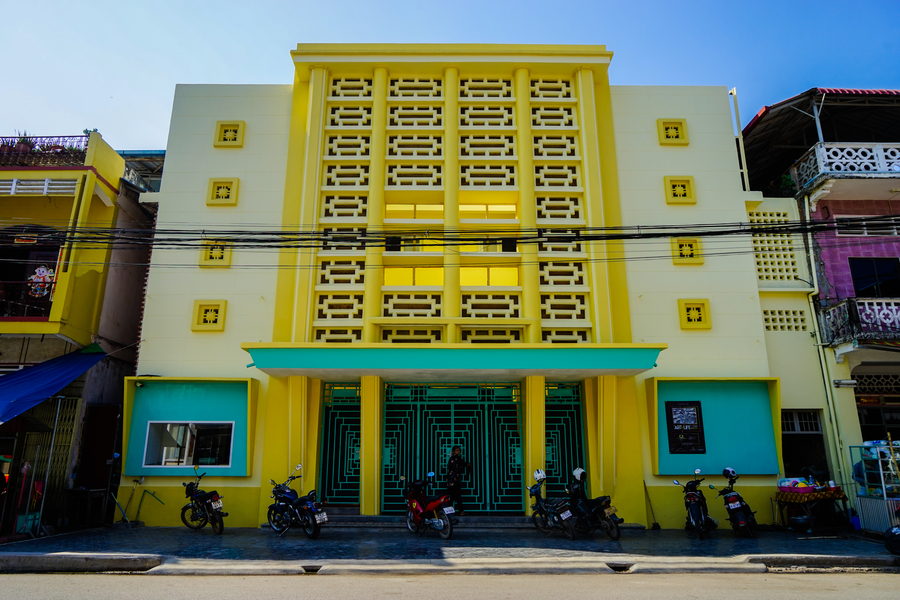
St. Tropez of the Far East
The next day, I make my way a little over half an hour from Kampot to the quiet seaside town of Kep, originally known as “Kep-sur-Mer” when the French made it into a sunny, coastal escape for colonists and Khmer elites. Even after independence, Kep continued to host the monied crowd as the jewel of the Cambodian Riviera. In the 50s and 60s, then-Prince Sihanouk started construction of a summer palace here, and many wealthy Khmers followed suit with their own stylish villas.
One morning, we drive around Kep to see some of the more than 100 remaining houses built in the New Khmer Architectural style, a boxy, minimalist marriage of the modernist movement and traditional Khmer elements. They’ve mostly been abandoned now, decaying shells tagged with graffiti, a casualty of the Khmer Rouge era which descended especially heavily on this area for its sin of living a lavish lifestyle corrupted by Western capitalist ideas.
But even their half-century of neglect comes as an oddly soothing reminder that perhaps not all change is good. We continue driving through the Kep countryside, along its blissfully quiet coastline, past a woman shelling tiny crabs by the beach while her toddler snoozes in the shade. At Angkul Beach, a little girl swings carefree in a hammock while a woman reluctantly fixes me a cup of the dankest black coffee I’ve ever had. “Do you have any milk?” I ask her in my rusty Khmer. She shakes her head and goes back to mending her fishing nets. Seeing what I’ve seen, I can’t help but smile at her insouciance to cater to tourists. How is it possible that this quiet corner of the Cambodian coast has managed to escape the frenzy of development?
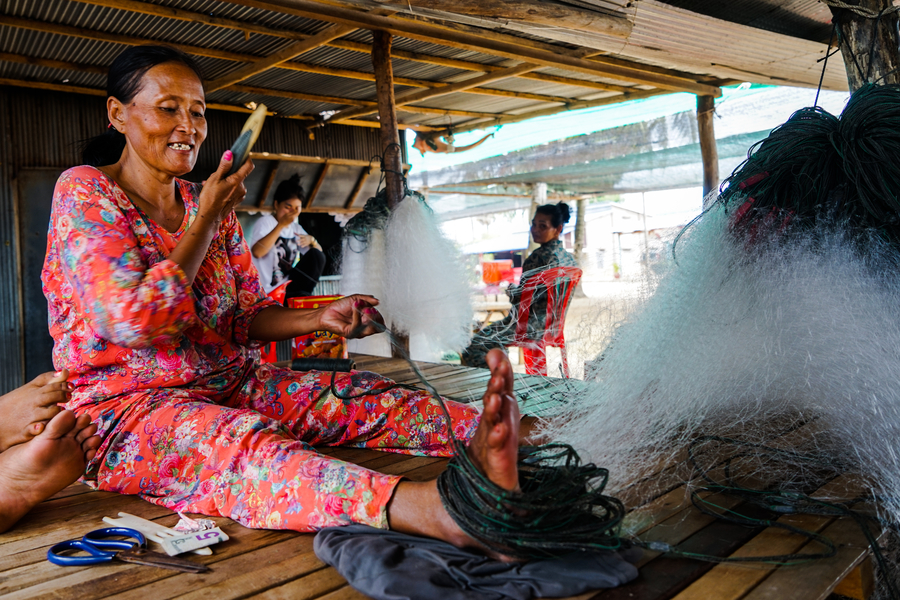
“Kep isn’t really a beach destination,” says Jonathan Manstein of Samanea Resort. “The water isn’t great for swimming because the Kep coastline is mostly mangrove marshes and black rock.” That said, the luxe 12-villa resort has carved out a pretty sweet mirage, with its shimmering blue swimming pool and palm-fringed sandy beach bookended by lush mangroves, all backed by Kep National park. “The beauty of Kep is its quiet, relaxed vibe. It’s not for people who want to party. You can go to Kampot for that. Here, you can do lots—take a trip to the islands, visit the countryside, head to the Crab Market—or do nothing at all.”
I take up Jonathan’s recommendation and head down to the Crab Market where women wade out and haul up bamboo traps filled with live crab over which much pinching, fondling and haggling is done. It’s said that Kep crabs are especially flavorful due to favorable breeding conditions in the mangroves and the availability of a particular kind of seaweed the crabs feed on. The seafood can then be brought home, cooked up on the spot with a few strands of Kampot peppercorns, or eaten in the adjacent row of seafood restaurants built over the water.

Made its own province in 2008, Cambodia’s smallest in size and population, there’s a quiet prosperity in the salty Kep air. “The government of Kep is using their money wisely,” notes Jonathan. “The highway here is probably the best road in Cambodia with street lights powered by solar and wind energy. There are also lots of places to work so there’s very little poverty. If Kep were its own country, it certainly wouldn’t be third-world.”

While Kep has nothing of the overt opulence of Sihanoukville, I notice subtle signs of a town that’s comfortable in its own skin—public beach tents and portajohns that line the main boardwalk blissfully free of any advertising and a town beach with a fresh new layer of golden sand, a significant improvement on the dark, grimy beach of my memories. Looking out over the pretty blue-green water towards Phu Quoc, the sky alight with flaming reds and oranges of sunset, happy hour drink(s) in hand, I decide here and now that it’s time to create new memories.
“Kep was once the St. Tropez of the Far East,” says Jonathan. “It was a place where people, both Westerners and locals, could come and just relax and be happy. Now, it’s come full circle.”
Welcome to the new Cambodian Riviera.
Images by James Pham
If You Go…
From Saigon, Cambodia’s southern beaches are accessible by going overland either via Phnom Penh or Ha Tien on the Vietnamese side. The total trip of two bus rides will take around 9 hours.
Alternatively, Cambodia Angkor Air has daily flights to Sihanoukville. If you time it right, a one-way flight can be as little as USD70 with just carry-on.
Naia Otres Beach Resort (www.naiacambodia.com) offers a slice of what Sihanoukville used to be with a lovely stretch of shaded beach and clean, comfortable rooms accented by bright pops of color. There’s an excellent beachfront restaurant on-site (the BBQ ribs are especially good) and the resort organizes boat trips to the islands.
Just opened mid-March, Six Senses Krabey Island (www.sixsenses.com) is all about a secluded island getaway with focus on health and wellness. The generously-sized pool villas meld into the lush island surrounds, each with en-suite spa-style bathroom and sundrenched indoor and outdoor living spaces. Doubles start at USD 530 per night, including breakfast, airport and boat transfers. Enjoy 20 percent off and a Khmer set dinner with the current Green Season offer.
A 10-minute speedboat ride from Ream, Alila Villas Koh Russey (www.alilahotels.com) invites guests to live the Alila lifestyle, a contemporary interpretation of luxury. Choose from pavilions with garden or ocean views or spectacular 1-, 2-, or 4-bedroom villas. Outside the resort, with its 1.5km-long crescent beach, the island is refreshingly lightly developed. Garden Pavilion Rooms start at USD315++ per night. A Stay 4, Pay 2 offer through October 31 includes breakfast and return island transfers.
The Boutique Kampot Hotel (www.boutiquekampot.com) celebrates Kampot’s unique heritage with its beautiful, French colonial-inspired façade and tastefully vintage décor. Just a five-minute walk to the riverside, the 18 rooms in cool shades of blue and grey are uncommonly spacious while the cheery ground floor restaurant is a welcoming place to enjoy the included breakfast.
Butterfly Tours (www.butterflytours.asia) offer insightful tours led by student guides in Battambang, Siem Reap, and Kampot. Locally-operated, many of the tours are by bicycle for more intimate, close-up views. My walking tour of Kampot’s heritage buildings as well as a motorbike tour of the area’s rural pepper farms and salt fields were both very good.
Samanea Beach Resort & Spa (www.samanea-resort.com) offers Kep’s most spacious accommodations in 12 bungalows spread out over the resort’s lush gardens. The private beach is the site of spectacular sunsets and the longest pier in the region. An infinity pool, spa, panoramic
rooftop bar, and excellent restaurant round out the facilities. Doubles start at USD165 including breakfast. Oi readers receive up to 50 percent off when booking direct.
Adventure sports enthusiast and all around good guy, Didier Rexach, runs half- and full-day activity tours around Kep (Facebook: Kep Activity) including climbing, trekking and motorbike tours. Our full-day jaunt around the Kep countryside was filled with fun forays down barely-there paths for an authentic look at this beautiful region.

